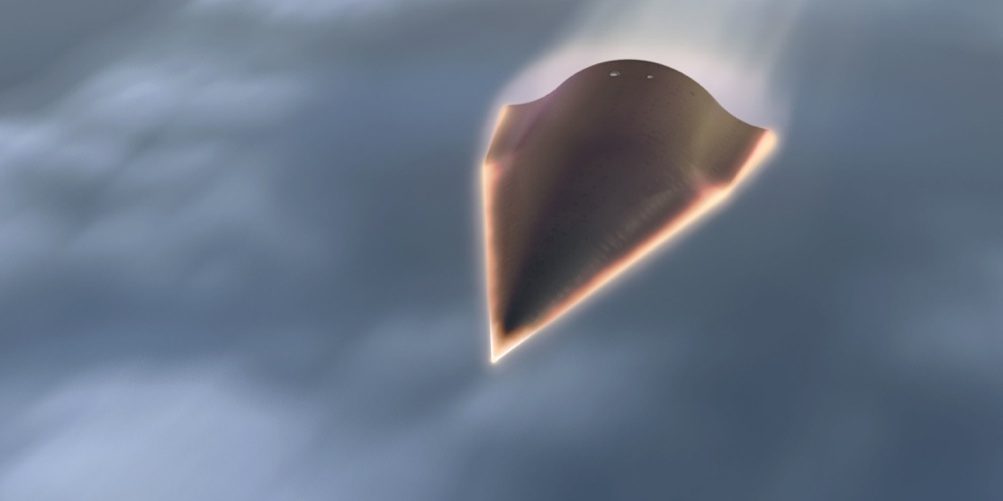The President thinks we have the best missiles in the world. The truth is far different: our missiles do not work.
“We have the super-fast missiles — tremendous number of the super-fast. We call them ‘super-fast,’ where they’re four, five, six, and even seven times faster than an ordinary missile. We need that because, again, Russia has some.” Donald Trump, February 2020
“We have a — I call it the ‘super-duper missile.’ And I heard the other night, 17 times faster than what they have right now….and you take the fastest missile we have right now — you’ve heard Russia has five times, and China is working on five or six times. We have one 17 times.” Donald Trump, May 2020
“We are building…rockets, and missiles; even a hypersonic missile that goes 17 times faster than the fastest missile currently available in the world and can hit a target 1,000 miles away within 14 inches from center point.” Donald Trump, July 2020
For years now, Donald Trump has been hyping the existence of a “super-fast” missile—something he calls the “super-duper missile” capable of flying “17 times faster” than the nearest competition.
Some believe that Trump is referring to the AGM-183A missile that is being developed under the Air-launched Rapid Response Weapon (ARRW) program. The US Air Force awarded a contract worth more than $480m to Lockheed Martin for designing the ARRW in August 2018. An initial test of the missile was done in 2019. Lockheed Martin received a $988.8 million contract modification for the ARRW critical design review, test and production readiness support, in December 2019. A second ARRW missile was tested in 2020. The US Air Force requested $382m in funding for the ARRW program development 2021 and another $581 million for 2022. The goal was to produce a total of 33 ARRW missiles for testing by December 2022.
But in March 2023, after a series of test failures and cost overruns, Air Force acquisition executive Andrew Hunter told the House Armed Services Committee that the AGM-183 ARRW program was being shut down. According to Hunter, the Air Force planned to focus more on the scramjet-powered Hypersonic Attack Cruise Missile, or HACM. To this end, the US Air Force requested $384 million for fiscal year 2024 to continue development of the HACM, down from $425 million spent in 2023.
But there was one major problem—the HACM, like the AGM-183A, didn’t work. Confronted with this reality, the Air Force put HACM on ice for a year and brought the AGM-183A back to life.
Despite nearly $2 billion being spent on both systems, as things stand neither HACM nor ARRW are anywhere near operational. Indeed, it is not known if either design works the way the Air Force intends.
Contrary to what President Trump has been extolling, if the AGM-183A is the “super-duper” missile he referenced, then it exists only as a figment of his imagination.
There is another possibility regarding the identity of the “super duper” missile, that being the much touted and highly anticipated Long-Range Hypersonic Weapon (LRHW), better known as “Dark Eagle.” In July 2024, at the NATO Summit in Washington, DC, the Biden administration announced that it had agreed with the German government to deploy the Dark Eagle system on German soil beginning in 2026.
Artists conception of a Dark Eagle battery in action
While Europe waits for the delivery of America’s first foray into the world of operational hypersonic weaponry, the Trump administration decided to flex its hypersonic muscle, deploying a Dark Eagle battery, together with its parent unit, to Australia as part of the Talisman Sabre 25, the largest-ever joint military exercise between the US and Australia designed to showcase America’s commitment to push back against Chinese adventurism in the Indo-Pacific region.
There was one major problem, however. While the US Army deployed various launchers, support vehicles, command and control equipment and personnel associated with a Dark Eagle firing battery, there were no live missiles launched during this training for one very specific reason—there were no operational Dark Eagle missiles deployed to Australia.
Because none exist.
The Dark Eagle, like the HACM and the AGM-183A, involves technologies that the United States simply isn’t familiar with, and as such unable to master to the degree necessary to field an operational missile. The weak link for Dark Eagle is what is known as the Common Hypersonic Glide Body—the winged delivery system that enables a warhead to be delivered to its target at high speed, while maneuvering. According to the US Army, the maximum speed of the Common Hypersonic Glide Body is Mach 17—17 times the speed of sound—the same speed of Donald Trump’s imaginary “super-duper” missile.
The Common Hypersonic Glide Body will be boosted into the atmosphere aboard what is known as the “All Up Round” (AUR), a two-stage solid fuel rocket which requires new, lightweight, high-efficiency materials which can deliver the performance necessary while enabling weight to be shifted to the all-important Common Hypersonic Glide Body. The Common Hypersonic Glide Body itself requires special materials capable of operating at a wide range of temperatures—from extremely hot, when the Common Hypersonic Glide Body is boosted to its initial operating speeds, to lower ranges as it slows down during re-entry and begins maneuvering.
The United States has never dealt with such materials before, and finding the right mix that can achieve the entire spectrum of heat management has been a challenge. Because of weight management issues, the focus on getting the heat absorption materials right means that the testing for Dark Eagle has foregone other critical issues, such as lethality (can the warhead destroy anything) and survivability (can the warhead operate in a hostile electronic warfare environment.) The Department of Defense’s Director, Operational Test and Evaluation (DOT&E) is still engaged in what is known as Middle Tier of Acquisition (MTA) rapid prototyping testing, which is currently scheduled to be completed by the end of this year. This testing involves certifying the AUR and its launcher—something that is still lacking.
DOT&E has yet to provide a formal assessment of the operational effectiveness, lethality, suitability, or survivability of a Dark Eagle missile system. This means that the actual kinetic effects of the Common Hypersonic Glide Body are not known. Nor has it been demonstrated that the sophisticated guidance and control systems that enable Dark Eagle to maneuver and find its target can survive in the kind of hostile environment it would encounter in any engagement with a peer-level adversary such as Russia and China.
Normally when a new weapons system is deployed as part of a major exercise, the goal is to collect data as part of what is known as an Initial Operational Test and Evaluation (IOT&E) period—the final phase of testing to make sure a weapons system is combat ready.
By deploying Dark Eagle to Australia, the United States was engaged in a massive disinformation campaign, posturing as if it actually had a combat-capable weapon when in fact all that was deployed was a launcher that has yet to pass its final field trials loaded with inert missiles which posed a far greater risk to those handling them than to any potential enemy.
The primary contractor for Dark Eagle—Lockheed Martin, which has secured billions of dollars to produce a weapon that doesn’t (yet) work.
And as for the deployment of Dark Eagle to Germany, scheduled for next year? Highly unlikely—the most recent contract extension involving the Common Hypersonic Glide Body will not be finished until 2027, and perhaps 2028.
If at all.
The failure to date of the ARRW, HACM and Dark Eagle programs to deliver an operational missile to the US military customer represents a humiliating reality check for the Trump administration, which has been posturing itself as the driving force behind a US defense industry that was second to none. The fact is that the US remains far behind not only Russia and China in the field of operational hypersonic weapons, but also regional adversaries like North Korea and Iran.
A key factor in the failure of the US to successfully develop and deploy hypersonic weapons is the business model associated with weapons procurement. Developing and manufacturing hypersonic weapons systems require a highly specialized workforce that simply is not available to US defense contractors in an “off the shelf” capacity. It also requires specialized manufacturing and testing facilities which do not exist, and as such must be built from scratch.
To compensate for this lack of skill, knowledge and infrastructure, defense contractors engage in a process which places an emphasis on producing a minimally viable product designed to provide potential customers with the ability to recognize potential value but, because they remove capabilities that pose a risk to delivering the product on schedule, produce a product that does not meet requirements.
This is, literally, planned incompetence.
When applied to conventional weapons systems, this planned incompetence is a development model which allows the defense contractor to draw the customer (the US Department of Defense) in with a contract to produce a “concept”, and then modify and extend the contract as needed. This model maximizes profit at the expense of timeliness and, ultimately, quality.
Welcome to the world that gave us the F-35 fighter.
But when applied to the unknown world of hypersonic weapons, the “minimally viable product” model collapses into an endless series of missed timelines and technology gaps. The defense industry, so accustomed to the massive waste, fraud and abuse associated with defense procurement contracts, can’t even “fake it to make it”.
Their incompetence is there for the entire world to see—if anyone is looking, that is.
It appears that some in Congress are starting to pay attention.
Artists conception of the Sentinel missile in flight
The US Air Force has, for some time now, been articulating the need for a replacement land-based intercontinental ballistic missile (ICBM) to replace the aging Minuteman III, which the Air Force reported to Congress would reach the end of its service life in 2036. The proposed solution to this problem was the LGM-35 Sentinel which, when publicly unveiled back in 2021, was a roughly $100 billion program designed to produce 600 new ICBMs that would be ready to be fielded in 2029.
The Sentinel program does not involve exotic new technologies, like the hypersonic programs do. It is a standard run of the mill weapons procurement project, overseen by Northrup Grumman, a long-time mainstay of the US military industrial complex. Northrup Grumman knows how to play the game, especially considering the 2007 Nunn-McCurdy Act, which requires the Department of Defense (DOD) to report to Congress whenever a Major Defense Acquisition Program (MDAP) experiences cost overruns which exceed certain thresholds. The Nunn-McCurdy Act envisioned two kinds of breaches—a “significant” breach, when a contract exceeded 15% of its current baseline estimate or 30% or more over the original baseline estimate, and a “critical” breach, which occurs when the cost increases 25% or more over the current baseline estimate or 50% or more over the original baseline estimate.
As such, it took everyone by surprise when, in July 2024, the Sentinel program came in at a whopping 81% over the original baseline estimate. Normally, this would lead to widespread issues with the defense contractor which would result in the contract being terminated. However, given the fact that the US Air Force desperately needed a replacement for the Minuteman III, and that there was no alternative for this replacement other than the Northrup Grumman Sentinel, the Department of Defense instead ordered an 18-24 month pause in the contract to buy time for Northrup Grumman to “restructure” the program.
However, when Congressional oversight exposed the fact that the Trump administration was using sleight of hand to transfer nearly a billion dollars from the Sentinel program to fund the renovations necessary to transform a Qatari-donated Boeing 747 airliner into a replacement for Air Force One, responsible for transporting the President, the reality of the bloated budget and inability to deliver a viable product prompted a complete workover of the Sentinel program. Today, the Air Force is being told it will need to plan on keeping Minuteman III in service up through 2050. This will require the cannibalization of missiles to keep others in service, since the supply chains associated with Minuteman III are no longer in existence and spare parts that were procured in the original contract have long since been used.
In short, the US ICBM force is in a state of crisis.
The timing of these issues could be more critical. In February 2026 the last remaining arms control treaty between the US and Russia (New START) expires. This treaty currently caps the number of deployed strategic nuclear weapons at 1,550. If it expires, it is anticipated that the US would immediately seek to transform the Minuteman III ICBM—originally designed to carry three warheads, but which had, because of treat-imposed limits, been downsized to a single warhead configuration—back to carrying three warheads. The problem is that the 450 Minuteman III missiles currently deployed will soon be dropped to 400 because of age. If called upon to continue testing and undergo cannibalization, the number of Minuteman III ICBMs available for operational use could drop to as low as 300.
And, because of the age of the missile, the ability to convert it back to a three-warhead system is not assured.
The cancellation of New START would trigger an immediate nuclear arms race. Russia would be compelled to increase the number of warheads on its deployed delivery systems to somewhere around 4,500. The US would fall some 450 warheads short of its planned increase in deployed nuclear warheads, meaning that it would start a new arms race in rough parity with Russia, and immediately fall behind, with no mechanism in place to catch up until at least 2050.
The last thing the US needs right now is a nuclear arms race with Russia.
Russia has mastered hypersonic technology, not only with short- and intermediate-range weapons systems, but also strategic, where the Avangard hypersonic maneuvering warhead has been deployed on several different ICBM systems.
Unlike the US military industrial complex, which has demonstrated that it is incapable of producing a viable new ICBM, the Russians have a vibrant defense industry which has fielded several new ICBM missiles over the past few years, and is currently involved in testing new missiles to ensure that the Russian ICBM force remains modern and viable,
Russian President Vladimir Putin has recently announced that he would be open to a one-year moratorium on the New START caps on deployed strategic nuclear weapons, allowing time for the US and Russia to begin arms control negotiations for a replacement treaty vehicle that would prevent a new nuclear arms race between the US and Russia. While President Trump has issued off-the-cuff comments suggesting his readiness to discuss such a proposal, the fact is his administration lacks both the structure and guidance to follow through.
If President Trump fails to provide the leadership necessary to kick-start the kind of robust, viable arms control negotiating team capable of engaging with the Russians with a realistic eye toward resolving the many issues that are linked to a new arms control agreement—issues that go far beyond the relatively simple issue of warhead caps, and tough upon missile defense, China, France, the UK, intermediate and short range missiles, and the complicated mechanism associated with treaty monitoring and verification—the United States will enter a race it is doomed to lose from the very start.
It’s a race we cannot afford to lose and therefore can never enter.


